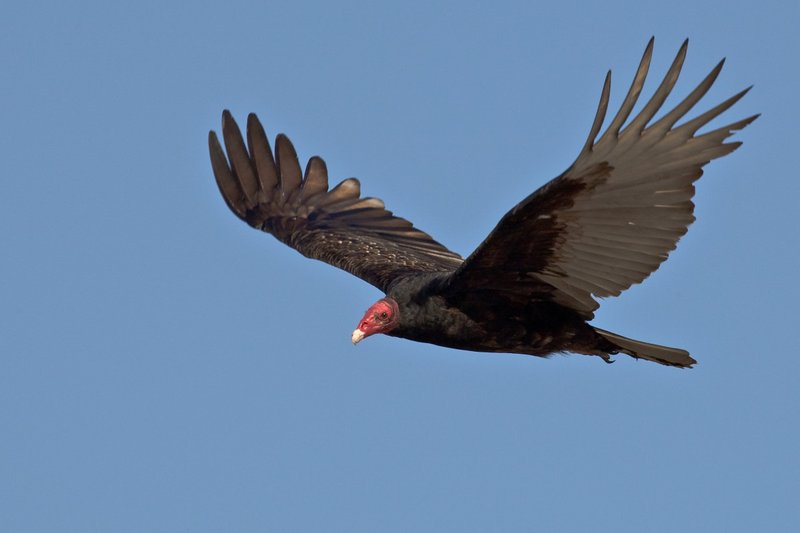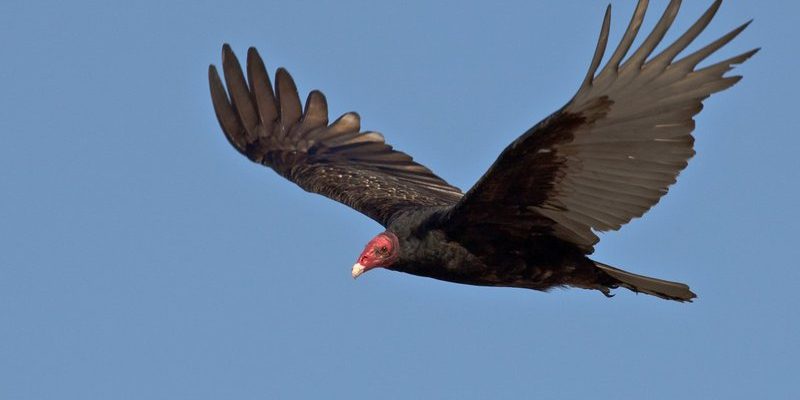
Imagine a skilled pilot navigating the skies, using every gust of wind to their advantage. That’s pretty much how turkey vultures operate. They can travel long distances without flapping their wings much, thanks to their ability to ride the warm air currents. Let me explain why these birds are so remarkable and how their hunting strategies set them apart from other species.
Turkey Vulture Anatomy: Built for Flight
One of the first things you notice about turkey vultures is their size. Weighing between 4 to 5.5 pounds with a wingspan of about 5 to 6 feet, these birds are built for soaring. Their long, broad wings catch air currents perfectly, allowing them to glide with minimal effort. This adaptation is crucial since they often need to travel vast distances in search of food.
Their feathers also play a role in their flying abilities. Unlike many birds, turkey vultures have a unique wing structure that includes less dense feathers, making them lighter and better at manipulating air flows. This is similar to how a skilled surfer rides the waves—using the natural forces around them to move efficiently. You might wonder how they can stay airborne for hours without getting tired. Well, it’s all about that clever body design combined with an incredible sense of thermal winds.
The Role of Thermals
Turkey vultures are masters of thermal flying. What does this mean? Simply put, thermals are rising columns of warm air. When the sun heats the ground, warm air rises, and vultures take advantage of this phenomenon to gain altitude without exerting much energy. They circle in these thermals, gaining height with barely a flap of their wings, and then glide off to cover vast distances in search of food. This energy-efficient flying technique is one of the things that sets them apart from other birds.
You might see these birds circling overhead, often in groups, all taking turns riding the same thermal. It’s an impressive sight! Think of it as a free ride in an elevator—the vultures are just hanging out until they’re ready to find their next meal.
Hunting Techniques: Masters of Scavenging
Now, let’s dive into their hunting strategies. Unlike predators that actively hunt living prey, turkey vultures are scavengers. They have a keen sense of smell, which is quite rare among birds. This ability helps them locate carrion, or dead animals, from several miles away. Imagine being able to sniff out dinner from such a distance; it’s like having a built-in GPS for food!
Turkey vultures primarily eat animals like roadkill or livestock that have died from natural causes. While some might find scavenging unappealing, it’s a vital role in the ecosystem. By consuming dead animals, they help clean up the environment and prevent the spread of disease.
The Importance of Vision and Smell
You might be wondering how they even spot their meals. Turkey vultures have excellent eyesight for spotting food from high in the sky, but what sets them apart is their extraordinary sense of smell. While many birds rely on sight, turkey vultures can pick up on the scent of decaying flesh thanks to specialized olfactory receptors. It’s as if nature equipped them with a superpower for locating lunch!
When they detect a carcass, turkey vultures swoop down, often accompanied by other scavengers, to take advantage of the feast. They can also spot their friends and fellow scavengers, like coyotes or other vultures, to help them find a meal. It’s all about teamwork in the wild!
Foraging Behavior: From Air to Ground
Once a turkey vulture finds a potential meal, it’s not just a simple scoop-and-go. Their foraging behavior is an intricate dance between the air and the ground. When they approach a carcass, they’ll carefully assess the situation from above. This means they’re not just diving straight in; they’re surveying the area for potential dangers or competition.
Once they decide it’s safe, they land and begin feasting. Their powerful beaks are designed for tearing into tough skin, which makes it easier for them to reach the nutritious meat inside. Here’s a fun fact: turkey vultures often have a preference for larger carcasses since it allows them to eat their fill before leaving for another meal.
Social Feeding Habits
Turkey vultures also exhibit surprisingly social behavior when it comes to feeding. They often gather in groups at a carcass, sharing the meal. This behavior isn’t just about being social; it helps them take down larger animals and eat more efficiently. You might see them working together to break into tough skin or defend their meal from other scavengers wanting a piece of the action.
This communal approach can be likened to a potluck dinner, where everyone brings something to the table. It makes scavenging more effective, ensuring that they all get their share before the meal is gone.
Environmental Adaptations: Thriving in Diverse Habitats
One of the most impressive aspects of turkey vultures is their ability to adapt to various environments. You’ll find them in forests, deserts, and even urban areas. Their flexibility allows them to thrive in places where food sources may vary year-round.
For instance, in urban areas, they may feast on roadkill or garbage, showcasing their adaptability. Here’s the thing: turkey vultures are incredibly resourceful, which is essential for survival. They quickly learn where to find food, whether it’s in the wild or in populated areas where humans may inadvertently provide for them.
Conservation and Status
Despite their adaptability, turkey vultures face challenges, primarily due to habitat loss and poisoning from bait meant for other animals. Conservation efforts are critical to ensure these birds can continue to thrive in their environments.
You might be wondering about their population status. Fortunately, turkey vultures are not endangered and are considered a species of least concern. However, being aware of their habitat and minimizing pesticide use is essential to protect these incredible birds.
The Role of Turkey Vultures in the Ecosystem
Lastly, it’s important to highlight the invaluable role that turkey vultures play in our ecosystem. By consuming carrion, they help to keep the environment clean and prevent the spread of disease. Without scavengers like them, dead animals would accumulate, leading to potential health risks for humans and other wildlife.
Think of turkey vultures as nature’s cleaners. They not only remove decaying matter but can also help to balance the ecosystem by controlling diseases that can spread through decomposing animals. Their unique hunting and flying techniques make them crucial players in maintaining a healthy environment.
Turkey vultures might not be the most glamorous birds in the sky, but their unique flying and hunting techniques are undeniably impressive. From their remarkable ability to soar on thermals to their specialized scavenging skills, they play a vital role in our ecosystem. Next time you see a turkey vulture gliding overhead, take a moment to appreciate this remarkable bird and all the hard work it does to keep our environment clean and balanced. Who knew that something so seemingly simple could have such a profound impact?

